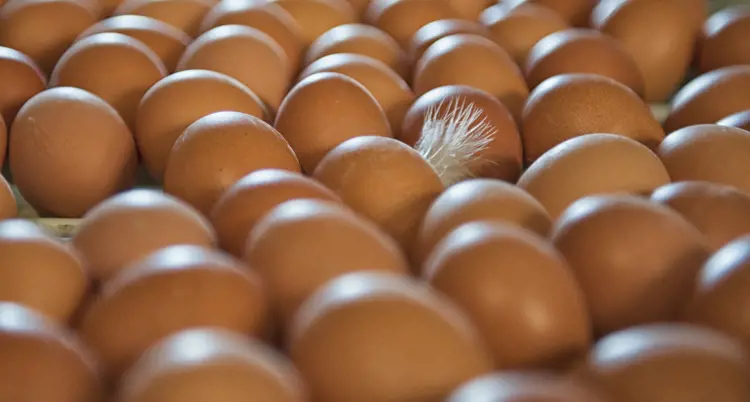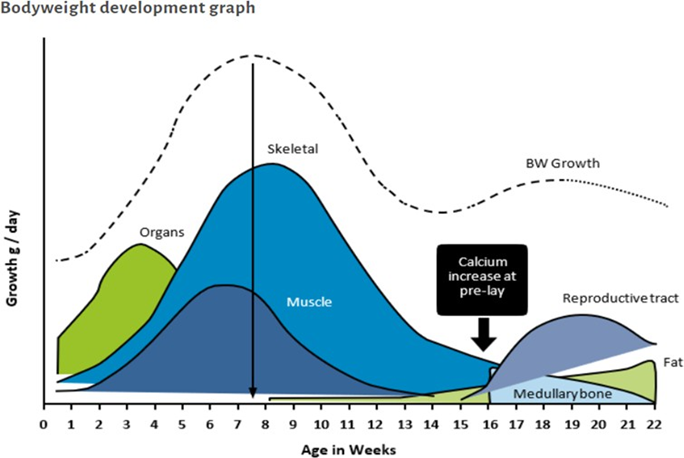How to influence egg weight in laying hens
It is startling to learn that eggs are classified from tiny to giant based more on weight than on size. Because of their genetic potential, heavier breeds are characteristically linked to the production of heavy eggs. In addition to a laying hen's genetic makeup, several factors can affect egg weight. A bird's first egg should be laid at around 18 weeks, and as it grows older, its production rate and size increase.


Fig. 1: Typical egg laying production and egg weight curve for a laying flock
To give farmers advice about egg weight and production potential, breeding companies have produced production profiles. However, even within a flock of similar age and parent stock, achieving uniform egg size is still difficult. This demonstrates the significance of managing variables unrelated to a laying hen's heredity. Now we can see that closely managing birds starts in the pullet house rather than only at the laying house. Egg weight increases within a 20–25-gram range (which is not much), but the time it takes to reach the optimum weight matters.
Why does a rearing period matter?
“If a farmer does not raise his pullets, he will always need to be aware of the producer's production history”, farmer X said. To manage the flock by how the birds were bred, purchase point-of-lay birds from a reputable breeder and inquire about the average weight (with CV%) at 16 weeks, vaccination, lighting, and feeding schedules. The laying shed is not where magic starts.

Fig. 2: Growth and development of a laying hen
The performance of laying birds is guaranteed to improve as birds mature, provided careful layer pullet rearing. In this way, birds will grow to a consistent size and produce eggs that are almost the same size from the onset. The combination of a bird's genetic potential and management techniques applied during rearing results in fully mature birds during their lifetime laying period.
With good management, egg weight can be increased by postponing the onset of lay. Early onset can increase the rate of lay, but the size remains small; it would be wise to allow birds to delay the start of laying (23 vs. 19 weeks of onset).
Importance of precision feeding techniques
Feed intake is stimulated during rearing to ensure that high feed intake occurs at laying. A higher intake causes an earlier start to lay heavy eggs in a growth-friendly environment. A bird must be fed a nutritionally balanced diet to meet its nutritional requirements, mainly its first limiting nutrient, which calls for a balanced diet. Water intake is essential for a healthy and reproducing bird because food consumption alone is insufficient. Compared to non-laying birds, laying birds drink more water which is twice as much feed. Birds tend to eat more during the coolest parts of the day, which are early in the morning and late in the evening. The timing of eating routines is crucial. A farmer must make sure that birds go to bed with full crops and awaken to feeders that are ready to dispense feed.
Stocking density has a significant impact on feed and water intake. It's crucial to prevent overcrowding of birds on nipples and feeder troughs. Water for birds at any given time must be of the same quality as water for human use to avoid production-related issues. This is equally important to feed quality and texture, both of which must be constantly evaluated. A farmer who monitors the daily water consumption of his laying sheds will quickly notice a decrease in water consumption and pay immediate attention to the behaviour, performance, and health of the birds.
The effect of lighting
Light promotes laying hens’ sexual maturity and egg production. The smallest details in lighting are crucial during the rearing of laying hens. Laying hens are vulnerable to early sexual maturity due to prolonged lighting hours that increase day length, in this way, a shorter day is crucial for birds during rearing. On preparation to lay, at about 16 weeks, light exposure for pullets must gradually increase to roughly 14 hours of light each day. The flock should be encouraged to enter the lay by this period.
You must keep a schedule of at least 14 hours of light every day for a flock to lay throughout the year. Late in the egg-producing cycle, you can gradually increase the quantity of light to 16 hours each day to help the flock continue to produce eggs. For laying flock, a 60-watt light bulb works just as well. Premature mature layers are less than ideal in all areas of body development, and as a result, the impact on the birds will include, among other things, malformed eggs, cracked eggs, rectal prolapse, and restlessness.
Selection of birds for laying sheds
At about 16 and 17 weeks of age, birds are selected for transfer to the laying shed. Body weight and frame size are the main points of selection criteria. Birds of large skeletal structure indicate good sexual maturity and the ability to lay eggs.
When choosing which birds to transfer to a laying house, flock uniformity is a key factor. By weighing birds at specific intervals, uniformity must be monitored and regulated in this manner, where low-weight birds are not selected. A small number of birds rejected during selection results from good bodyweight and body frame monitoring, which also provides information about the timing, size, and peak of egg production. Egg size uniformity is negatively impacted by choosing birds with a wide range of sizes. The point of lay bird supplier must deliver birds with an average weight that has a maximum CV of 10%. The higher the expectation for performance in terms of egg size, the lower the CV%.
Flock health monitoring
While managing the flock by moving around, you may keep the birds busy and look more closely at individual birds to check for symptoms of illness and other anomalies. Healthy feces will be firm, grey, or brown, with white pee deposits but no visible feed remnants that haven't been digested. Vaccination of the flock against common diseases is crucial, together with the implementation of good biosecurity standards.
Impact of laying hen stressors
Laying hens are very sensitive to stress, and in reaction to stress, reduced egg production and general performance will become apparent. Stressors include, but are not limited to, changes in housing environment, weather, feed, housing, water source, stocking density, and disease prevalence.
Feed restriction causes physiological stress in chickens, especially in the early stages of life where rapid growth and development occur. Both quantitative (amount) and qualitative (inclusion) feed restrictions must be detrimental to a laying hen’s performance. Feeding the wrong feed, diluting feed with scratch grains, or limiting the amount of feed available can result in your hens having a nutritional deficiency, causing them to molt and go out of production. When hens have a nutritional deficiency, it is common to see feather pecking as well as a loss of egg production.
The hens will not eat if they cannot drink water, so make sure that your watering system is functioning correctly. Keeping a watering system operational can be a challenge in the winter when the water may freeze.
The prevalence of diseases is a common problem for laying hens, and sick birds are unlikely to thrive as well as those that have not experienced any sickness challenges. Always screen your birds for local common poultry diseases using sentinels or serology samples from a small number of representatives. A local veterinarian may give vaccination schedules for farmers to follow in terms of disease prevention. It is usually advised to fully apply biosecurity measures to make sure that all farm procedures safeguard the welfare of the animals from external as well as internal factors.
The main environmental stressors that are temperature-related are heat stress and the amount of space available. The apparent signs of a bird experiencing heat stress include panting, decreased activity, poor feed intake, and an increase in mortality in situations when laying hens are exposed to severe heat (see figure 3). This will lead to substandard production, which will impact the weight and quality of the eggs. It has been suggested that poultry species apply vitamin C to reduce the effects of heat stress.

Fig. 3: A typical reaction of a laying hen to heat stress.
High stocking density is recommended for triggering competitiveness of the birds within the flock to stimulate feed and water intake. However, the bigger-sized birds will always get priority on feeding, and uniformity deteriorates under high-sticking conditions. In this way, birds will lay varying sizes of eggs, which affects the egg weight. Figure 4 shows birds panting in a highly stocked shed, which is the combination of more than 2 laying hen stressors.
Conclusion
Apart from genetics, the egg weight can be influenced by a wide range of factors which can not only be controlled at laying. Most egg producers who are financially stable opt to rear their pullets to ensure full control over all the aspects that influence egg weight.
For more information on how to influence egg weight in laying hens, please contact your De Heus technical advisor - https://www.deheus.co.za/meet-our-team
